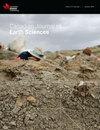与橄榄岩及含橄榄岩地下水相互作用对二氧化碳封存的评价。加拿大纽芬兰西部岛屿湾蛇绿岩的实验研究。
IF 1.6
4区 地球科学
Q3 GEOSCIENCES, MULTIDISCIPLINARY
引用次数: 0
摘要
本研究测量了含超基性岩石的各种水介质(即模拟超碱性和碱性地下水以及去离子水)中CO2气体通量。碱性和超碱性水模拟了在陆地超碱性体中发现的不同地下水的水化学和离子浓度。实验在密闭的实验室内进行,实验室内配有CO2分析仪,每秒测量实验室内的气态CO2浓度。监测了反应流体中总无机碳以及水相Ca、Mg和Si的含量。这三种流体都能隔离二氧化碳。在去离子水中加入橄榄岩破碎后,顶空CO2浓度降低了70 ppm(±9 ppm, 1σ, n=3),计算出的CO2通量为-2.5 × 104 mol/m2min(±9 × 105 mol/m2min, 1σ, n=3),而在超碱性富钙水中观察到的CO2通量最大,为-1.40 × 103 mol/m2min(±3 × 105 mol/m2min, 1σ, n=3),顶空CO2浓度降低了323 ppm(±4 ppm, 1σ, n=3)。利用傅里叶变换红外光谱(FTIR)检测了超碱性水体中方解石的存在,以及有无超镁质岩石。碳质量平衡模型表明,固体碳酸盐在超碱性水实验中沉淀,在4小时内转化了高达59%的从室顶空去除的二氧化碳。根据这些实验中收集的数据推断,估计在地表条件下,如果有足够的停留时间,纽芬兰群岛湾复群的超镁铁质岩石可以吸收多达400万吨的大气二氧化碳。本文章由计算机程序翻译,如有差异,请以英文原文为准。
Evaluation of Carbon Dioxide Sequestration via Interaction with Peridotite and Peridotite Hosted Groundwaters. An Experimental Case Study with Bay of Islands Ophiolite Rocks, Western Newfoundland, Canada.
This study measured the CO2 gas flux into various aqueous media (i.e., simulated ultra-basic and basic groundwater, and deionized water) containing ultramafic rock. Basic and ultra-basic waters simulated the aqueous chemistry and ion concentrations of distinct groundwaters found within terrestrial ultramafic bodies. Experiments were performed in a closed chamber in line with a CO2 analyzer, which measured the gaseous CO2 concentration in the chamber every second. Total inorganic carbon, as well as aqueous species Ca, Mg, and Si were monitored in the reaction fluids. All three fluid types sequestered CO2. The addition of crushed peridotite to deionized water reduced the CO2 concentration in the headspace by 70 ppm (± 9 ppm, 1σ, n=3) and had a calculated CO2 flux of -2.5 x 104 mol/m2min (± 9 x 105 mol/m2min, 1σ, n=3), while the greatest CO2 flux was observed in ultra-basic Ca-rich waters of -1.40 x 103 mol/m2min (± 3 x 105 mol/m2min, 1σ, n=3) which reduced the headspace CO2 concentration by 323 ppm (± 4 ppm, 1σ, n=3). The presence of calcite was detected using FTIR in ultra-basic waters in the presence and absence of ultramafic rock. A carbon mass balance model, indicated that solid carbonates were precipitated in the ultra-basic water experiments, converting up to 59% of the CO2 removed from the chamber headspace in four hours. Extrapolating the data collected in these experiments, it was estimated that at surface conditions, with an adequate residence time, the mass of ultramafic rock in the Bay of Islands Complex in Newfoundland could sequester up to 4 million tonnes of atmospheric CO2.
求助全文
通过发布文献求助,成功后即可免费获取论文全文。
去求助
来源期刊

Canadian Journal of Earth Sciences
地学-地球科学综合
CiteScore
2.80
自引率
7.10%
发文量
66
审稿时长
6-12 weeks
期刊介绍:
The Canadian Journal of Earth Sciences reports current research in climate and environmental geoscience; geoarchaeology and forensic geoscience; geochronology and geochemistry; geophysics; GIS and geomatics; hydrology; mineralogy and petrology; mining and engineering geology; ore deposits and economic geology; paleontology, petroleum geology and basin analysis; physical geography and Quaternary geoscience; planetary geoscience; sedimentology and stratigraphy; soil sciences; and structural geology and tectonics. It also publishes special issues that focus on information and studies about a particular segment of earth sciences.
 求助内容:
求助内容: 应助结果提醒方式:
应助结果提醒方式:


